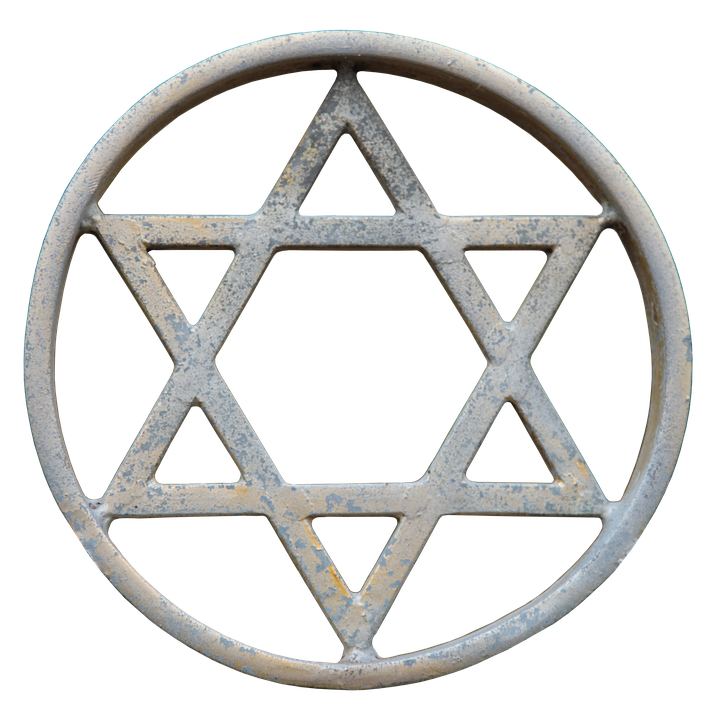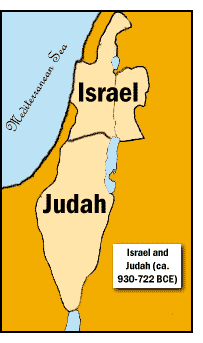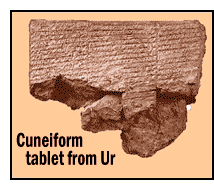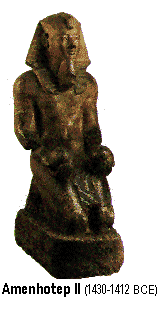
1. Terminology
Judaism, Jew, Judea, etc.
Unfortunately, many of the terms associated with Judaism are virtually indistinguishable in common usage. The terms “Judaism,” “Jew,” “Jewish,” “Judea,” and “Judeans” for example, are all based on the name of the patriarch Judah, one of the 12 sons of the patriarch Jacob (conveniently listed in Gen. 35:23-26). The story of the births of these brothers, along with Dinah, their only sister, which is an amazing account of wifely competition, is recorded in Gen. 29:16 – 30:24 and 35:16-18.

Strictly speaking, the terms “Judaism” and “Jew(s)” should not describe Israelites earlier than 721 B.C.E., the year that the Assyrians conquered the northern nation of Israel, leaving only the southern nation of Judah. From that time on, “Judah” was used synonymously with “Israel” and “Jew” with “Israelite,” even for descendants belonging to tribes other than Judah. This is because by 721 B.C.E., and for almost 200 years previously, “Judah” referred not only to the tribe that descended from Judah himself, but also to the political entity composed mainly of the tribe of Judah, but also including the tribes of Benjamin, Simeon, and most of Levi, with members of other tribes included as well. In actual usage, however, “Judaism” and “Jewish nation” applies to the entire history of Israel, from its founder, the patriarch Abraham, Jacob’s grandfather (c. 1800 B.C.E.). The related term, “Judaea” was the name the Romans gave to the southern portion of Palestine after they took control in 60 B.C.E.
Israel, children of Israel, Israelites, Israelis
Because God renames Jacob “Israel” (Gen. 32:28), these boys are called “the sons of Israel,” and their descendants “The 12 tribes of Israel,” “the children of Israel,” or simply “Israelites.” This should not be used interchangeably with “Israelis,” which properly refers only to citizens of the modern nation of Israel.
Hebrews
A rarer term is “Hebrew,” used only 34 times in the Old Testament. Two theories compete with each other regarding the origin of this name. Some say it comes from “Heber,” an ancestor of Jacob’s grandfather, the patriarch Abraham (Gen. 11:14-26). Abraham is called a “Hebrew” (Gen.14:13), and the name “Hebrews” is often applied to his many descendants through his son Isaac and his grandson Jacob (Gen.39:14, 17; 40:15; Exod.3:18; 1 Sam.4:6; 14:11; Phil.3:5). (The name “Hebrew,” however, does not apply to Abraham’s many descendants through his son Ishmael. These people the Bible calls “Ishmaelites,” according to Gen.25:12-18 and are held by tradition to be the ancestors of the Arabs.) A second theory is that it comes from a similarly spelled Hebrew verb, ‘abar, which means “to cross over.” Hebrews, then, would be those who have crossed over some boundary, in other words, foreigners. The logical boundary it might refer to is the Euphrates River (see Josh. 24:15).
Habiru, Hapiru, SA.GAZ
Archaeologists have long debated whether the biblical term “Hebrew” is related to the name “Habiru” or “Hapiru” or the cuneiform name SA.GAZ. These three are found in documents of Mesopotamia, Syria, Palestine, and Egypt of the second millennium B.C.E. Here is a helpful summary of the ongoing debate (LaSor, Hubbard, and Bush, 207):

The earliest mention of the SA.GAZ or Habiru occurs in a text from the Third Dynasty of Ur (ca. 2050); if the ‘pr and Habiru are the same—which is not at all firmly established—references to the Habiru can be found in Assyrian, Babylonian, Ugaritic, Egyptian, and Hittite texts for the next seven or eight hundred years.
Identification of the Habiru with the Hebrews is tempting, and a number of scholars have adopted it. However, it is impossible to interpret most references to the Habiru as also indicating the Hebrews. Moreover, the Habiru are described as warriors, mercenaries, marauders, and caravaneers all over the ancient Near East—which does not fit the biblical picture of the Hebrews.
If the Exodus was in 1446, then at the same time the Hebrews were in the wilderness of Sinai, [the Egyptian pharaoh] Amenhotep II (1438-1412) was reporting the capture of 89,600 prisoners, among them 3,000 ‘Apiru, from his campaign in Syria and Palestine. If it [i.e., the Exodus] was in 1290, then the Hebrews were still slaves in Egypt at the time of Amenhotep. Neither case permits an easy identification.
The problem of the Habiru cannot be solved here. The important point is that identification of the Habiru with the Hebrews is not easy.
LaSor, Hubbard, and Bush (1982: 207)

It appears that “Habiru” is either a broad term for semi-nomadic peoples, of which the Hebrews were one component, or not an ethnic term at all but a sociological one—a class of wanderers who do not consider themselves subject to local laws and who hire themselves out for caravans, mercenary armies, or as servants of one kind or another. The breadth of the occupations described by the word as well as the extensive geography involved, has led many scholars to conclude that “Habiru” came to be used rather loosely as a derogatory term for anyone in a menial capacity, or anyone who was a foreigner.
Semitic
Another broad term is “Semitic,” though non-Biblical, comes from Shem, one of the three sons of Noah, many generations prior to Abraham. All of Shem’s descendants can be called “Semitic,” which would include both Arabs and Jews, though modern usage often limits the term to the Jews only.
Want to dive deeper?
Here are some sources you can pursue in your study of the terminology of Judaism:
Less advanced:
1982 LaSor, W. S.; Hubbard, D. A.; and Bush, F. W. Old Testament Survey: The Message, Form, and Background of the Old Testament. Grand Rapids: Eerdmans. 206-207.
1983 Yamauchi, Edwin. “Habiru,” 223-224 in New International Dictionary of Biblical Archaeology. Ed. E. M. Blaiklock and R. K. Harrison. Grand Rapids: Zondervan.
More advanced:
1965 Von Rad, Gerhard, and others. Article on Israel, Israelite, Jew, Judea, Jewish, Judaize, Judaism, Hebrew, Hebraic, etc., 3:356-391 in Theological Dictionary of the New Testament. Ed. Gerhard Kittel and G. W. Bromiley. Grand Rapids: Eerdmans.
1969 Harrison, R. K. Introduction to the Old Testament, with a comprehensive review of Old Testament studies and a special supplement on the Apocrypha. Grand Rapids: Eerdmans. 318-325.
1976 Mayer, Reinhold, and others. “Israel, Jew, Hebrew, Jacob, Judah,” 2:304-323 in New International Dictionary of New Testament Theology. Ed. Colin Brown, and others. Grand Rapids: Zondervan.
1980 Harris, R. L. “‘abar word group” “‘eber,” and “‘ibri,” 2:641-643 in Theological Wordbook of the Old Testament. Ed. R. L. Harris, G. L. Archer, Jr., and B. K. Waltke. Chicago: Moody.
1981 Bright, John. A History of Israel. 3d ed. Philadelphia: Westminster.93-96, 134-143.
Online resources:
Links for studies on Habiru/Hapiru/‘Apiru
2. Formative events
The origin of Judaism is largely dependent on a few significant historical events, which would certainly include the call of Abraham, the Exodus, the United Kingdom, and the Babylonian exile. We will briefly look at each in turn.
The Call of Abraham
The LORD called Abram to leave his country and family for a place the LORD would show him (Gen. 12:1-4; Acts 7:1-4). After the death of his father Terah, Abram set out from Haran in what is now southeastern Turkey and traveled to Canaan (now in Israel).
Over the next 25 years, after starting out on that journey, Abram learned and responded to the faithfulness of God. Sarai was still childless and well beyond the child-bearing years, yet the LORD promised not only that Abram would have an heir, but that his descendants would be as numerous as the stars (Gen. 15:4-5).
Despite the physical obstacles, Scripture states that Abram “believed the LORD, and He credited it to him as righteousness” (Gen. 15:6). This trust Abram had in the LORD, this unwavering loyalty, became the model for all believers in the LORD who were to follow. Abram became known as the “friend of God” (2 Chron. 20:7; James 2:23) and the “father of the faithful” (Gal. 3:6-9).
The LORD entered into covenant with him, marking the changed relationship by the sign of circumcision as well as by changing Abram’s name to Abraham and his wife’s name to Sarah (Gen. 17).
God blessed him with wealth and finally with Isaac, the “son of promise.” Abraham also received God’s promise of land, though during his lifetime, the only real estate he owned was the burial site he purchased at Hebron, the cave of Machpelah.
Isaac, Abraham’s heir, continued the semi-nomadic lifestyle of his father and renewed his father’s covenant with the LORD. His son, Jacob, or Israel, established the family of 12 sons whose descendants became known as “the twelve tribes of Israel.”
Clan becomes a nation
Because of a drought in Canaan, Jacob’s entire family moved to the delta region of Egypt, where they stayed for the next 400 years (Gen. 38-50). During this time, the extended family of 70 became a great nation of some 3 million. This is summarized in Deut. 26:5–7:
Under the leadership of Moses and Aaron, and by the miraculous intervention of the LORD in the 10 plagues and the crossing of the Red Sea, the Israelites broke free of the slavery they had endured during the final generation of the 400-year period in Egypt (see Exod. 1-15).
The Israelites assembled around Mt. Sinai, where they witnessed the awesome glory of the LORD and entered into covenant with Him who is the God of Abraham, Isaac, and Jacob (see Exod. 19 – 24).
The covenant document, inscribed on two stone tablets, is now known as “The Ten Commandments” (Exod. 31:18; 34:1-32). Much of the rest of the Law of Moses is an explanation of these ten principles as they apply in the daily life of the nation.
David and the United Kingdom
For another extended period, after the Israelites entered into and mostly conquered Canaan under Joshua (recorded in Joshua), the 12 tribes remained a loose confederation united mainly by their shared covenant with the LORD. The leadership exercised by what English Bibles have traditionally called “Judges” was sometimes both spiritual and military, sometimes only one or the other, and seldom involved the entire nation (see the Book of Judges).
Toward the end of the ministry of the prophet Samuel, the last of these “judges,” the nation demanded a king to lead them, ignoring the aged prophet’s warnings of the dire consequences of rebelling against the kingship of God Himself (1 Sam. 8). Under God’s direction, Samuel anointed Saul as the nation’s first king. After a good beginning, Saul’s position and power corrupted him to the point that he flagrantly disobeyed the LORD’s direct orders and received from Samuel the LORD’s rebuke and rejection (see 1 Sam. 9:1 – 13:14).
Saul’s successor, David, did the most to unite the nation, winning victories over all of its enemies in the bordering nations, and extending the territory of the country to include all of the lands God promised to Abraham (1 Chron. 22:18-19). David also led the nation to a renewal of its worship of the LORD. He set a wonderful example of personal devotion to God (see 2 Sam. 6:1-15; 7:1-29; 22:1 – 23:7; 1 Chron. 29:10-22), despite his dreadful sins (2 Sam. 11 – 20; 24:1-25; 1 Chron. 21:1-28), wrote much of the nation’s hymnbook (the Psalms), and prepared the way for a national sanctuary, the temple his son Solomon built that stood for nearly 400 years (1 Sam. 22 – 26; 28 – 29; 1 Chron. 23 – 29).
Ever after, the people looked back to the reign’s of David and Solomon as Israel’s golden age. They looked forward to the time when the Son of David would arise and restore the nation to its former glory (see Ps. 118:50; Isa. 9:2-7; Ezek. 34:23-24).
Exile in Babylonia
After the death of Solomon, the nation divided, with Judah ruled by Solomon’s son Rehoboam and Israel (most of the other tribes) ruled by Jeroboam. Jeroboam led Israel into a perverted worship of the LORD that involved an unauthorized priesthood, different feast days, and official shrines at the northern and southern extremities of the nation, featuring idols resembling calves. Despite the rebukes of prophets like Elijah, Elisha, Hosea, Joel, Amos, and Jonah, Israel continued in its rebellion against the LORD until the Assyrians destroyed its capital in 721 BCE and carried off many of its citizens into an exile from which they never officially returned.
David’s dynasty, meanwhile, continued to rule Judah, though often ruthlessly and wickedly. Although God was very patient with David’s line, He did permit the Assyrians under Sennacherib to punish them severely (701 BCE), conquering all of the cities of Judah except Jerusalem (see 2 Kings; 2 Chron.; Isa. 36-39). The deliverance Jerusalem experienced at that time created a spiritual revival under the leadership of the prophets Micah and Isaiah and their patron, King Hezekiah.
Hezekiah’s son Manasseh, however, was very wicked and led the nation away from the LORD. Of the kings that followed, only Josiah was devoted to God. The nation slid into apostasy to the point that God, through the prophet Jeremiah, announced that its destruction was unavoidable. The Babylonians, successors to the Assyrians in imperial power, became the overlord of Judah. They removed the upper class of the nation to Babylon in 605 BCE and again in 597. Ezekiel, Daniel, and Daniel’s three friends Hananiah, Mishael, and Azariah (better known by their Babylonian names: Shadrach, Meshach, and Abednego) became exiles at this time.
Because Judah renewed her rebellion against the Babylonian King Nebuchadnezzar, the powerful ruler laid siege to Jerusalem and conquered her in 586 BCE, taking another group of Israelites back to Babylon.
Rise of synagogues
The fall of Jerusalem to Nebuchadnezzar in 586 BCE marked the end of the First Temple, the one Solomon had built in about 920. For the first time in more than 300 years, the Israelites could not offer sacrifices or worship at the temple in Jerusalem. It was during this period of the Babylonian Exile that their local assemblies, or “synagogues” (from a Greek word that means “come together”) became important.
Even after the return from exile and rebuilding of the temple became possible after the Babylonians fell to the Medo-Persian empire (539-516 BCE), the synagogues remained a vital component of Judaism. Not only did the synagogue become a place for the Jews to worship and read the Scriptures, but it was also their school, their civil court, their social assistance center, and their community center.
By the First Century CE, the synagogue was a long-established institution, as demonstrated in Matthew, Mark, Luke, John, and Acts. Jesus and Paul both used the synagogue as a center for religious instruction (see Luke 4:15-30 and Acts 13:14-48). They understood Christ’s church to be the synagogue perfected, reaching its ultimate fulfillment in magnifying God, submitting to Jesus as Messiah and Lord, and in its acceptance of Gentile believers, finally realizing the promise God made to Abraham, “In your offspring, all the nations of the world will be blessed.”
Of course, those who rejected Jesus as the Messiah rejected His followers also, and eventually excluded them from their synagogues, a process often called “The Great separation.” This process accelerated after the Roman destruction of Jerusalem and the Second Temple in 70 CE, this time by Roman legions under Titus. The Jewish Christians, who refused to participate in the Jewish rebellion against Rome, were regarded as not only apostate because of their allegiance to Jesus, but also disloyal to the nation.
As a result, Christianity and Judaism divided, and only in very recent times has anyone made much of an effort to bring them back together again in the Messianic Jews movement.
Want to dive deeper?
1996 LaSor, W. S.; Hubbard, D. A.; and Bush, F. W. Old Testament Survey: The Message, Form, and Background of the Old Testament. Grand Rapids: Eerdmans.
1999 Blackaby, Henry T. Created to be God’s Friend: How God shapes those He loves. Nashville: Thomas Nelson. (Lessons based on the life of Abraham).
2000 Bright, John. A History of Israel. 4th ed. Phildelphia: Westminster.
